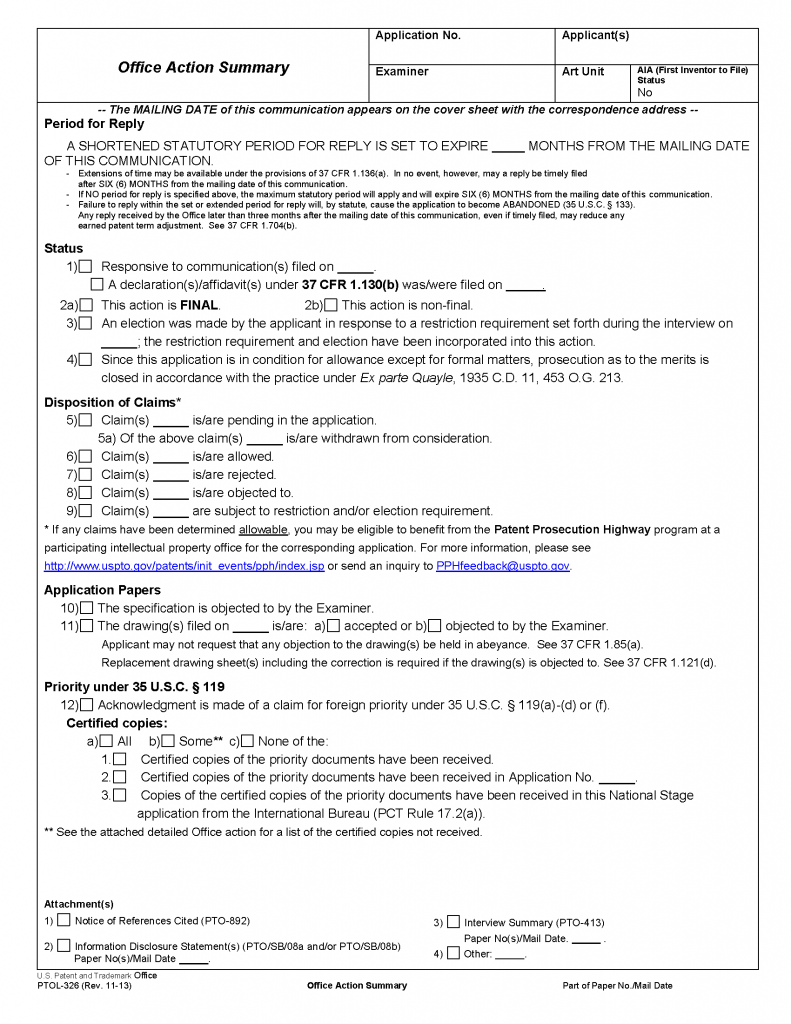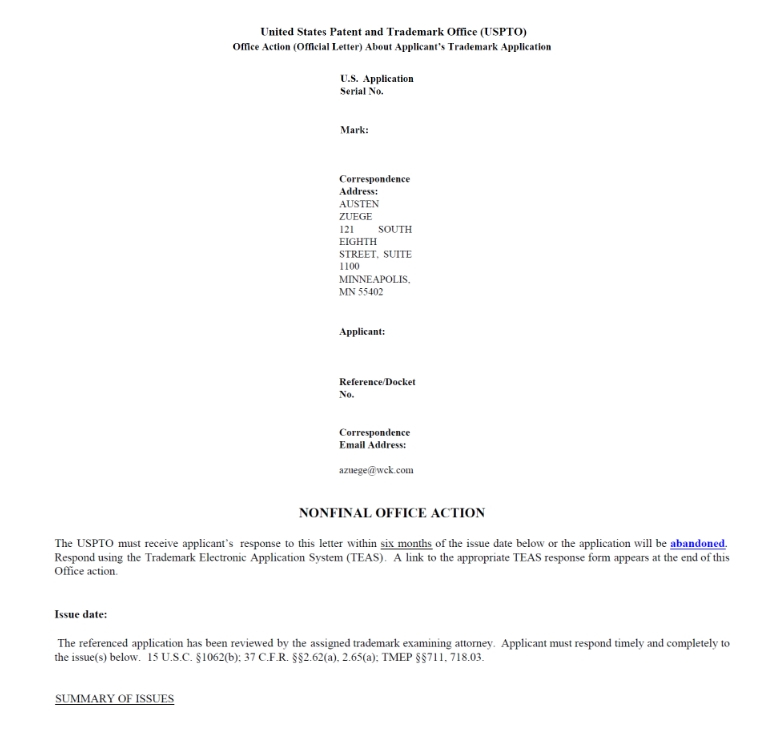“Office actions” are official communications about patent or trademark applications. In general, an office action specifies a reason (or perhaps multiple reasons) why an examiner believes that a patent or trademark registration cannot be issued. Applicants can generally file a response to an office action within a specified period of time. Specific types of office actions are discussed below. Skip to: patent or trademark.
Patent Office Actions
For patent applications, an office action makes a rejection or objection, or both, for some aspect of the application. Office actions are part of patent “examination” or “prosecution”. An office action is prepared by a patent examiner assigned to examine the given application to assess patentability. So, in other words, the office action indicates why the examiner believes a patent cannot be granted.
Most commonly, office actions will reject some or all claims of the application for (allegedly) being unpatentable in light of cited “prior art”, which might be an existing patent for a similar invention, for example. Though an office action might also indicate that some claims are patentable (allowable).

The first page of an office action is a cover sheet with important mailing/sending date information. The next page is a summary. The remainder explains the substantive basis for the rejection or objection. Multiple office actions can be issued for a given patent application. Though eventually an office action will be made “final”, meaning the examiner considers prosecution closed.
There are other types of official communications that are not “on the merits”, like restriction and election requirements. Patent practitioners typically use different terms to refer to those other communications. That distinguishes them from regular office actions dealing with patentability.
Office actions are common. The overwhelming majority (almost 90%) of all new patent applications receive some sort of rejection or objection in an office action. So there is nothing unusual about receiving one. Most importantly, an applicant is generally still able to file a response to continue pursuing patent protection even if a rejection is made. An office action just opens up the opportunity for back-and-forth dialog between the applicant and the examiner regarding patentability.
However, an important feature of an office action is that it establishes a response deadline. The applicant will need to take action to respond to the office action by that deadline in order to keep the patent application active. Failure to respond will result in abandonment and loss of rights. Extensions of time to respond to an office action are available, though such extensions carry an official fee.
In other countries, different terminology may be used. Office actions may instead be called notices of reasons for refusal, examination reports, search reports, written opinions, etc.
Trademark Office Actions
For federal trademark (and service mark) applications, an office action (or official letter) will state grounds for refusal of registration. Office actions are part of trademark “examination” or “prosecution”. Office actions are prepared by trademark examining attorneys assigned to particular applications. The office action indicates why the examiner believes a mark cannot be registered.

Office actions will often reject part or all of the application for (allegedly) creating a “likelihood of confusion” with a conflicting prior registration. Though it is also common for trademark office actions to raise formalities requiring action or amendment, such as to change the wording in some part of the application.
Multiple office actions can be issued for a given trademark application. Though eventually an office action will be made “final”.
Trademark office actions are common. There is nothing unusual about receiving an office action for a trademark application. Most importantly, an applicant can generally still file a response to continue pursuing trademark registration even if a refusal is made. An office action just opens up the opportunity for a conversation between the applicant and the examiner regarding registrability.
An important feature of an office action is that usually establishes a response deadline. The trademark applicant will need to take action to respond to the office action by that deadline in order to keep the application active. Failure to respond will result in abandonment of the application. An extension of time to respond to an office action is available, though such extensions carry an official fee.
However, because U.S. trademark rights are based on use in commerce and registration is optional, abandonment of trademark application may not affect so-called “common law” rights stemming from ongoing use of a mark. Though the existence of a conflicting registration may mean there is a risk of infringement. And, if there has not yet been use of the mark, abandonment for failure to respond to an office action may result in a loss of a priority date—potentially allowing someone else to claim the mark.
Have an invention you would like to patent? Have a brand you would like to register as a trademark? Concerned about infringing someone else’s intellectual property? Is someone else infringing your IP? Need representation in an IP dispute? Austen is a patent attorney / trademark attorney who can help. These and other IP issues are his area of expertise. Contact Austen today to discuss.
